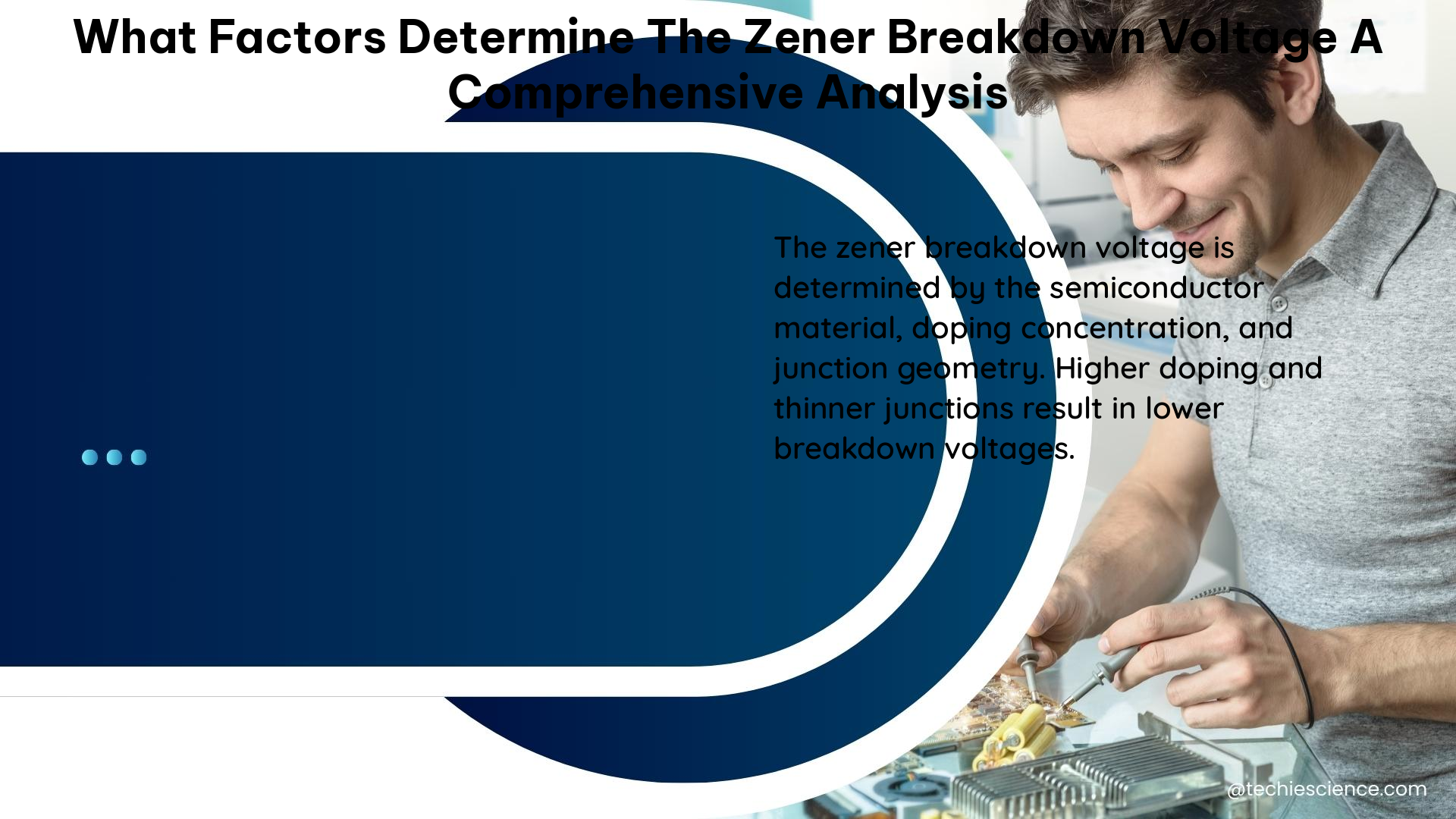The Zener breakdown voltage (Vz) is a critical parameter that determines the performance and application of a Zener diode. This comprehensive analysis delves into the various factors that influence the Zener breakdown voltage, providing a detailed understanding for electronics students and professionals.
Doping Level and Zener Breakdown Voltage
The primary factor that determines the Zener breakdown voltage is the doping level of the semiconductor material used in the Zener diode. During the manufacturing process, the semiconductor material is doped with specific impurities to create a p-n junction with a desired breakdown voltage.
- The Zener breakdown voltage is inversely proportional to the doping level of the semiconductor material. Higher doping levels result in lower Zener breakdown voltages, while lower doping levels lead to higher Zener breakdown voltages.
- Commercially available Zener diodes typically have Zener breakdown voltages ranging from 2.4 volts to around 200 volts, depending on the doping level.
- The doping level is precisely controlled during the manufacturing process to achieve the desired Zener breakdown voltage for a specific application.
Zener Test Current (Iz) and Validation

The Zener test current (Iz) is another essential characteristic that is closely related to the Zener breakdown voltage. It is the current that flows through the Zener diode when the applied reverse voltage equals the Zener voltage.
- The Zener test current is used to validate the Zener voltage during the manufacturing process. It ensures that the Zener diode meets the specified Zener voltage requirements.
- The Zener test current can vary depending on the power rating and intended application of the Zener diode. Diodes with higher power ratings typically have higher Zener test currents.
- For example, a Zener diode with a Zener voltage of 5.1 volts and a power rating of 1 watt may have a Zener test current of 200 mA, while a Zener diode with the same Zener voltage but a power rating of 0.5 watts may have a Zener test current of 100 mA.
Maximum Power Dissipation (Pz) and Thermal Runaway
Zener diodes have a maximum power dissipation rating (Pz), which is the maximum power the diode can dissipate without exceeding its maximum junction temperature. Exceeding this rating can lead to a condition known as thermal runaway.
- Thermal runaway occurs when the diode’s temperature and current increase exponentially, ultimately destroying the device.
- The maximum power dissipation rating is determined by the physical size and construction of the Zener diode, as well as the material properties of the semiconductor and packaging.
- Typical maximum power dissipation ratings for Zener diodes range from a few milliwatts for small-signal diodes to several watts for high-power Zener diodes.
- It is crucial to ensure that the Zener diode is operated within its maximum power dissipation rating to prevent thermal runaway and ensure reliable performance.
Zener Resistance (Rz) and Breakdown Region Behavior
The Zener resistance (Rz) is another important characteristic that describes the dynamic resistance of the Zener diode in the breakdown region.
- Zener resistance is calculated as the ratio of the small change in voltage (ΔVz) to the corresponding small change in current (ΔIz) in the breakdown region.
- Zener diodes with higher breakdown voltages typically have lower Zener resistance, while those with lower breakdown voltages have higher Zener resistance.
- The Zener resistance is an essential parameter for understanding the behavior of the Zener diode in the breakdown region, which is crucial for its application in voltage regulation and other circuits.
Maximum Reverse Current Rating
The maximum reverse current rating of a Zener diode is the maximum current that the diode can allow to flow through it when it is reverse-biased and operating in the Zener breakdown region.
- This rating is particularly important in applications where the Zener diode may be exposed to transient overvoltage conditions, such as in power supply circuits or surge protection circuits.
- Exceeding the maximum reverse current rating can lead to excessive power dissipation and potential damage to the Zener diode.
- Manufacturers typically specify the maximum reverse current rating for each Zener diode model, and it is essential to ensure that the diode is not operated beyond this limit.
Other Factors Influencing Zener Breakdown Voltage
While the doping level is the primary factor determining the Zener breakdown voltage, there are other factors that can also influence it:
-
Temperature: The Zener breakdown voltage exhibits a temperature coefficient, which means it can change slightly with changes in temperature. This temperature coefficient is typically specified by the manufacturer and should be considered in the design of Zener diode-based circuits.
-
Reverse Bias Voltage: The Zener breakdown voltage can also be affected by the level of reverse bias voltage applied to the diode. Excessive reverse bias voltage can cause the breakdown voltage to shift slightly.
-
Zener Diode Geometry: The physical size and geometry of the Zener diode can also impact the breakdown voltage, as the electric field distribution within the device can be influenced by the device structure.
-
Manufacturing Variations: Even with precise control during the manufacturing process, there can be slight variations in the Zener breakdown voltage from one diode to another due to inherent process variations.
By understanding these factors that determine the Zener breakdown voltage, electronics students and professionals can make informed decisions when selecting and designing Zener diode-based circuits for various applications.
Reference:
- Zener Diode: A Comprehensive Guide to Its Principles and Applications
- Zener Diode
- Zener Diode
- Zener Diode Characteristics

The lambdageeks.com Core SME Team is a group of experienced subject matter experts from diverse scientific and technical fields including Physics, Chemistry, Technology,Electronics & Electrical Engineering, Automotive, Mechanical Engineering. Our team collaborates to create high-quality, well-researched articles on a wide range of science and technology topics for the lambdageeks.com website.
All Our Senior SME are having more than 7 Years of experience in the respective fields . They are either Working Industry Professionals or assocaited With different Universities. Refer Our Authors Page to get to know About our Core SMEs.